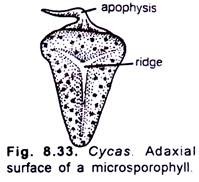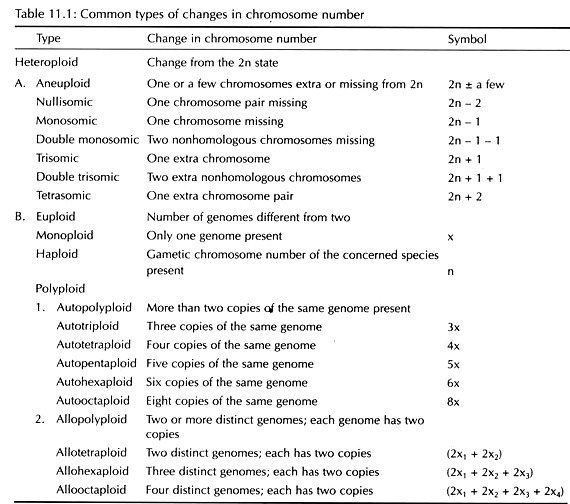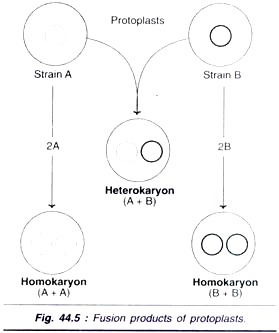In this article we will discuss about:- 1. Meaning of Aneuploidy 2. Forms of Aneuploidy 3. Importance.
Meaning of Aneuploidy:
Aneuploidy is the presence of chromosome number that is different from the simple multiple of the basic chromosome number. An organism which contains one or more incomplete chromosome sets is known as aneuploid. Aneuploidy can be either due to loss of one or more chromosomes (hypo-ploidy) or due to addition of one or more chromosomes to complete chromosome complement (hyper-ploidy).
Hypo-ploidy may be due to loss of a single chromosome – monosomy (2n – 1), or due to loss of one pair of chromosomes – nullisomy (2n – 2). Similarly, hyper-ploidy may involve addition of either a single chromosome-trisomy (2n + 1) or a pair of chromosomes (2n + 2) – tetrasomy (Fig. 11.2).
Forms of Aneuploidy:
Monosomy:
Monosomy is the phenomenon where an individual lacks one or a few non-homologous chromosome(s) of a diploid complement.
Types of Monosomy:
Single monosomies lack one complete chromosome (2n – 1), these create major imbalance and may not be tolerated in diploids.
Monosomies, however, are viable in polyploid species, in which the loss of one chromosome has a less marked effect. For instance, in ordinary tobacco, Nicotiana tabacum, which is a tetraploid species with 2n = 48 chromosomes, a series of different monosomic types with 47 chromosomes is known.
The number of possible monosomies in an organism is equal to the haploid chromosome number. Double monosomies (2n – 1 – 1) or triple monosomies (2n – 1 – 1 – 1) could also be produced in polyploids.
Origin of Monosomy:
The origin of the monosomies may be from the production of n – 1 types of gametes due to rare nondisjunction of a bivalent.
Meiotie Behaviour:
Monosomies show irregular meiosis (univalents in addition to bivalents). Moreover, in progeny of a monosomic, a mixture of disomic (2n), monosomies (2n – 1) and nuilisomics (2n – 2) is obtained.
Use:
Monosomic condition for a particular chromosome is associated with a characteristic morphology. Looking at the morphology of the monosomies, and of their progeny, genes could be located on a specific chromosome. In wheat, monosomies have been utilized with great success for the localization of different genes in specific chromosomes by Sears.
Nullisomy:
The plants in which a chromosome pair is missing, are called nullisomics. The chromosome formula would be (2n – 2) and not (2n – 1 – 1), which would mean a double monosomic. The number of possible nullisomics in an organism will be equal to the haploid chromosome number.
Origin of Nullisomy:
The origin of nullisomics is generally by the selfing of the monosomies.
Use of Nullisomy:
Nullisomics can be effectively used in locating different genes. In wheat, nullisomics have been obtained with 40 chromosomes instead of 42 chromosomes.
Trisomy:
Trisomies are those organisms, which have an extra chromosome (2n -t- 1). The number of possible trisomies in an organism is equal to the haploid chromosome number.
Types of Trisomy:
Trisomies are of different types —primary trisomies where extra chromosome is identical to two homologues; secondary trisomies where the extra chromosome is an iso-chromosome with two genetically identical arms; tertiary trisomies are the products of translocation (Fig. 11.3). Double trisomies (2n + 1 + 1) are also available in nature.
Origin of Trisomy:
The origin of the trisomies may be from the production of n + 1 types of gametes due to rare non-disjunction of a bivalent in a diploid or may also be produced by triploids through irregular meiosis (Fig. 11.4).
Meiotic Behaviour:
Trisomies show irregular’ meiosis (Fig. 11.5). Since the trisomies have an extra chromosome which is homologous to one of the chromosomes of the complement, they form a trivalent. Blakeslee and Belling obtained trisomic individuals in Datura stramonium having 25 instead of 24 chromosomes.
Gradually, all the 12 kinds of trisomies, which are theoretically possible, were obtained; each one of the 12 qualitatively different chromosomes in the genome appeared as an extra chromosome.
Use:
The trisomies are of significance in locating genes on specific chromosomes. The trisomies have somewhat poorer vigour and less fertility than the normal diploid form.
Tetrasomy:
Tetrasomics have a particular chromosome represented in four doses (2n+2). The types of possible tetrasomics is equal to the haploid chromosome number of an organism. All 21 possible tetrasomics are available in wheat.
Origin of Tetrasomy:
Tetrasomics may be originated by selfing of trisomies.
Meiotic Behaviour:
During meiosis, the four homologues of the tetrasomic set tend to form a quadrivalent.
Importance of Aneuploidy in Plants:
Aneuploids have played a role in evolution and have importance in plant breeding in addition to genetic analysis.
(a) Detecting linkage group:
The aneuploids have played an important role in locating a linkage group and a gene in a particular chromosome. Particularly nullisomics, monosomies and trisomies have been used to determine linkage groups in tobacco, wheat, etc.
The study of aneuploids have shown homoeology between A, B and D genomes of wheat. Identification of the chromosome involved in translocation has also been done with the help of aneuploids.
(b) Chromosome substitution in plant breeding:
The major contribution of aneuploids has been in the field of plant breeding. The substitution of whole chromosome or part of the chromosome using aneuploids has been done. These substitutions resulted in significant modification of yield, resistance, lodging, etc.
(c) Speciation:
Aneuploidy can generate variation and source of speciation in vegetatively propagating species. In Crepis, aneuploid variations form a series X = 3, 4, 5, 6 and 7 among species. A very extensive aneuploid series has been observed in Carex (n = 6 to 56).




